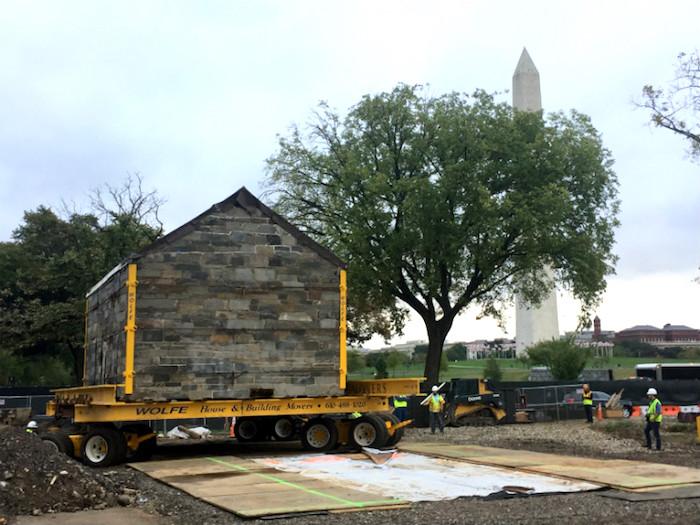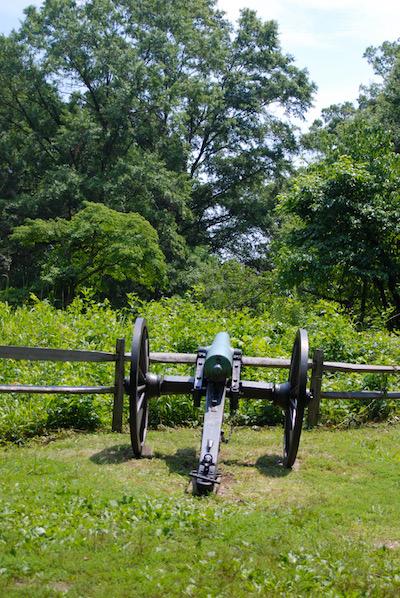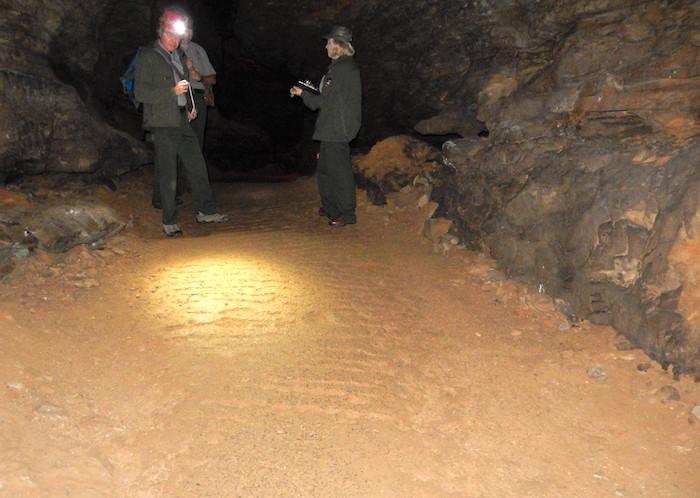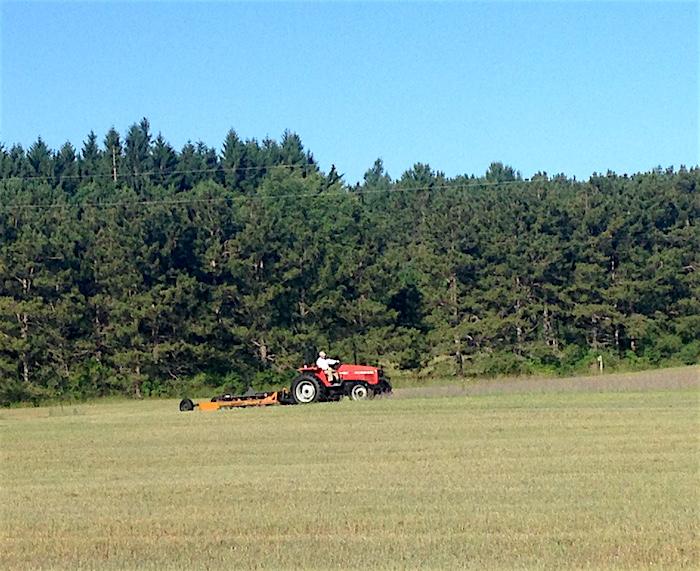
Moving buildings, such as the lockkeeper's house on the National Mall, sometimes is required to maintain national park landscapes/NPS
Imagine visiting Redwoods National and State Parks, sitting down on a bluff to watch the sunset, only to have it blocked by a bushy azalea. Or, on a visit to Acadia National Park, what would you think if your sweeping view of the rocky Atlantic coast was blocked by a grove of towering maples? What if you went to visit a Civil War battlefield but you couldn’t figure out where the battle took place, since the field was covered in thick hardwood forest?
These scenarios aren’t regularly playing out, however, thanks to ongoing maintenance done by the dedicated park staff, friends groups, and volunteers who work throughout the year to manage the 7 million acres of what are called maintained landscapes within the National Park System. These landscapes include urban parks, orchards, meadows, battlefields, campgrounds, and picnic areas.
There are walls, fences, masonry, walkways, irrigation systems and plantings that all need work, some more frequently than others. This category also includes historic, designed landscapes that commemorate a person or event; an historic site from a specific person or activity, such as Saint-Gaudens National Historic Site in New Hampshire that honors an artist; or an ethnographic landscape associated with sacred sites and settlements from previous cultures. They are all important places, essential to preserve and present within the National Park System unique chapters of American history.
But, as with many other aspects of maintaining the park system, there is a great need for more funding to stay on top of all the needs. Unfortunately, that money has not kept up with the needs.
Currently, there are nearly 10,000 assets whose maintenance has been deferred, with a funding backlog of $669,430,183. The 4,339 projects that are listed as being in “serious” condition need funding of $339,737,749. These projects range from maintaining the historic Kennecott cemetery in Alaska’s Wrangell-St. Elias National Park to the Crane Flat Campground in Yosemite National Park and from the landscape on Ellis Island at the Statue of Liberty National Monument.

Tree clearing is needed to maintain historic sight lines at national battlefields/Kurt Repanshek file
For example, at Fredericksburg and Spotsylvania National Military Park, tree clearing has been needed on occasion to present the view from Lee’s Hill as Gen. Robert E. Lee saw it on December 13, 1862, when his cannons rained hell down on Union troops. Farm fields that define the country’s agricultural heritage would return to their native state without intervention.
Hundreds of trained gardeners, landscape architects, and arborists toil, combating invasive species, climate variations, and human use and development to maintain these settings as historically accurate as possible. As they do, they try to end the use of traditional pesticides and fertilizers, reduce the emissions from machinery, and recycle organic debris.
The costliest, and most serious, project on the lengthy list is the rehabilitation (at a price tag of $148,003,450) of the Constitution Gardens at the National Mall and Memorial Parks in Washington, D.C. Part of the first stage of restoration included moving the 200-year-old Lockkeeper’s House (just 18 feet), the gateway to the garden landscape with its winding paths and willow-lined duck pond. In partnership with the Trust for the National Mall, a second phase will involve improvements and restoration of the 38-acre site, lake, and pavilion.
Eighty-five miles away in Pennsylvania, Gettysburg National Military Park is one the most visited, and most important, Civil War battlefields managed by the National Park Service. “We have well over 1 million people visit a year,” says Christopher Gwinn, the park’s chief of interpretation and education. “It’s one of the most iconic battlefields in the U.S. But it needs constant maintenance.”
That never-ending maintenance includes removing trees and rebuilding stone walls and fences. Keeping the fields cleared helps rangers interpret the agricultural community and the lives of the people who called this small-town home in 1863, for it was on these same fields that two great armies battled for the fate of the Republic.
Probably one of the most iconic, and most publicized sites at Gettysburg, is Little Round Top. “It was pivotal terrain for both sides,” explains Gwinn. “Most visitors just have to see it.”
Due to the popularity of the spot, it’s kept partially cleared so visitors can see the stonewalls and breastworks, or watch the sun set behind them, since the stony heights overlook much of the battlefield.
“There are tremendous issues protecting the landscapes,” adds Gwinn. “You find paths in the ruins, massive issues of erosion and soil compaction. There’s significant damage to breastworks, as people climb over them, and topple them.”
Visitors blaze their own trails too, and carve their names into what Gwinn calls “social trees;” plus, the parking lot is too small for the crowds.
Below Little Round Top, Gettysburg rangers have been focused for the past two decades on rehabilitating the battlefield. In fact, preserving these landscapes was the main reason Congress created the park in 1895. By mapping and understanding the 1863 battle landscape the park staff is able to preserve, protect, and present the key terrain, fields of fire, concealment and obstacles, and the avenues of approach.

The maintained surface of the National Park System even goes underground, at places such as Mammoth Cave National Park, where the Grand Avenue tour route is scheduled for reconstruction/NPS
Mammoth Cave National Park in Kentucky has a whole different sort of maintained landscape, and it’s underground. According to Molly Schroer, the park’s public information officer, the park has $78 million in deferred maintenance needs. Of that amount, $35,677,136 is designated for just trails.
“We are looking in late 2019, early 2020 to begin a backcountry trail review and try to get a handle on our trails, the use on the trails and how we move forward, and that’s going to then get us a plan on how we can work on that, the conditions of the trails,” says Schroer. “Those will probably include our trails underground.”
There’s a $13 million project on the calendar for Fiscal 2019 that will involve a full reconstruction of 2 miles of trail along one of the most popular tour routes, Grand Avenue. “That’s going to be a big impact on visitor tours for that period of time that construction is taking place,” she says. “But long-term it’s just going to create a nicer trail, better for the cave environment and a better experience for visitors.”
According to the spokesperson, the work will include, “hardening the path, improving some of the seating areas they have for rest stations along the way, creating some lint systems, or some guard systems, along the path that help the cave environment, to keep the lint and the dust from spreading around. Just improving the walkway. It’s a little slick in some areas because so many people go over it."
Up in the Canadian Shield country of northern Michigan, another national park unit is tasked with keeping the landscape as it once was.
Sleeping Bear Dunes National Lakeshore covers more than 70,000 acres just west of Traverse City. Rocky bluffs rise 500 feet above the Lake Michigan shoreline, with lakes and streams, forests, and fields inland. Here, on what’s called America’s Third Coast, families play on the dunes, visit historic coastal villages, and reflect on the area’s picturesque farm and maritime history. In summer, people hike, bike and canoe. In winter, they travel by cross county ski and snowshoe. And all of this is staffed with only 46 permanent, and 84 seasonal, employees who take care of this landscape that sees well over 1 million visitors a year. And it’s an economic powerhouse to the region, with annual visitor dollars of $183.1 million that help pay for 2,900 jobs.

Sleeping Bear Dunes National Lakeshore has many farms that must be maintained/Preserve Historic Sleeping Bear
But Sleeping Bear, like most park units, has its own backlog of maintenance projects totaling $20.2 million, with maintained landscapes (for fields, campgrounds and picnic areas) accounting for $2.1 million of that. They do have plenty of help, with over 850 volunteers, including two friends’ groups, who help manage the 369 historic structures, and 4,500 acres of cultural landscapes. They need nearly a million dollars to address deferred maintenance on the landscape around the historic South Manitou Island Lighthouse.
Susan Pocklington is the director of Preserve Historic Sleeping Bear, a nonprofit that for 20 years has helped maintain the integrity of the historic landscape. With so many historic farms and fields, it’s a big job.
“We don’t want the forest growing up to the farmhouse door,” she says. “Volunteers will remove invasive species, or encroaching vegetation, like the black locust. Last year we took different groups out to remove silver poplar. Four different groups came back that fall and it had already grown back in. It’s not easy work.”
The group owns a large tractor-mower, in collaboration with The Friends of Sleeping Bear, and mow close to 1,000 acres of fields every summer.
“Besides restoring trails and gardens, orchards are a big project. There are over 80 varieties of apples, including on North and South Manitou Island. We fund a grafting project to preserve the antique orchards, and we’ll transplant them back into historic orchards,” added Pocklington.
But with more trees, there’s more pruning; another job for volunteers.
Across the National Park System, there’s a lot of work that needs to be done, from the Dorchester Heights Grounds at Boston National Historic Park and General Grant’s Tomb Plaza in New York City to the beaches of Tenaya Lake in Yosemite.
The Park Service crews and volunteers are staying busy mowing fields, pruning trees, building trails, rebuilding stonewalls, and repairing fences. They’re doing the best they can, with the resources at hand, but every day a landscape project is deferred, it’s that much harder to bring it back.
Support for this reporting was provided by The Pew Charitable Trusts
Previous articles in this series:
Traveler Special Report: Closing The National Park System's Maintenance Backlog
Traveler Special Report: Some Friends Groups Asked To Provide "Margin Of Survival"
Traveler Special Report: Maintenance Woes Blocking Access To Parts Of National Park System
Traveler Special Report: Historic Sites And Structures Affected By Maintenance Backlog
Traveler Special Report: Antiquated Wastewater, Sewer Facilities Go Wanting In National Parks
Traveler Special Report: Backlog Of Maintenance Needs Creates Park Risks
Traveler Special Report: Maintenance Backlog Crippling To National Park Roads And Bridges
Traveler Special Report: Private Philanthropy Fills The Gaps Of Deferred Maintenance



Comments
Not sure of the sources on this article but as many know who have been in the NPS, a project isn't really a project until it has been programmed into a specific funding source. Just because a Park has put a cost estimate towards a project doesn't mean it is real.
For example, Consitution Gardens on the Mall has been forwarded as more of a major improvement including the addition of a new outdoor skating rink And concession stand to generate revenue for the partner. Don't think that Has much to do with just landscape.
But just because some yahoo has not authorized a proposal doesn't mean the need isn't there.
Can we possibly get the Actor's Guild and/or musical groups involved with this endeavor. We could have a massive concert/program (possibly in Washington DC) with a huge bank of phones for callers to call in manned by actors/entertainment-type people) with a donation. And also have an on-line fund raiser set up at the same time. It would be televised of course. If we got the right person/s behind this, we could make it happen and at least make a dent in this! Maybe we would shame the current leadership cadre into doing something to bring change. (Although, I realize this is a stretch - if nothing else, it would help them realize how much the Parks mean to America.)